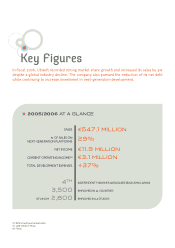Ubisoft 2005 Annual Report Download - page 18
Download and view the complete annual report
Please find page 18 of the 2005 Ubisoft annual report below. You can navigate through the pages in the report by either clicking on the pages listed below, or by using the keyword search tool below to find specific information within the annual report.
CHOICE GAMES
AT A COMPETITIVE COST
Game development using next-generation technology is extremely resource-intensive,
requiring more data, more time and increasingly large development teams – up to 200
people can be mobilized on one next-gen game, compared with 50-100 on current-gen
titles. Ubisoft was one of the first publishers to recognize the need to carefully prepare
for the challenges of this transition. Selective acquisitions, intensive recruitment for its
internal production studios and smart investment in next-gen technology have enabled the
company to both reinforce its reputation for quality and innovation – key factors in brand
creation – and to successfully pursue its strategy of early positioning on the next-gen market.
Moreover, thanks to the careful management of its distribution and structure costs,
Ubisoft has proved that creating superior games is not incompatible with being financially
sound. Consistently recognized for producing games of outstanding quality, Ubisoft’s
award-winning studios are part of a carefully planned human resources strategy which has
enabled the company to boast production costs significantly lower than the industry average
and to further reduce its net debt in the 2006 fiscal year despite growing investment
expenses. During this transition period, when industry costs are increasing and revenues
are down, Ubisoft’s efforts to constantly improve its cost structure have consolidated and
further expanded its technological lead. Its guiding principle: to continue producing the
best games at the lowest cost by building the most talented internal production force and
by leveraging its production expertise, tools and processes company-wide.
2ND LARGEST IN-HOUSE CREATIVE
FORCE WORLDWIDE
In fiscal 2006, Ubisoft further consolidated its position as the world’s 2nd largest inter-
nal production force, hiring an additional 470 people and taking the total number of
people working in its studios to 2,800 (out of a total of 3,500). With a production work-
force that has more than doubled over the past 3 years, and that is set to integrate ano-
ther 500 people in the next fiscal year, Ubisoft is actively pursuing its strategy of
growing the expertise it needs to continue developing innovative major titles internally.
With 14 studios in 11 countries, the strategic location of Ubisoft’s studios not only
allows it to attract the best and brightest talents from all over the world, but also
contributes to controlling the rising costs for next-generation titles: intensive recruit-
ment is focused in countries such as Canada and China that offer competent, trained
people as well as tax benefits or a lower cost structure.
In a talent-based industry, the combined force of Ubisoft’s experience-intensive and
resource-intensive studios constitutes a competitive advantage that will enable the com-
pany to achieve its ambitious growth objectives.
Creating quality games
people want to play
In-house development and consumer proximity lie at the heart of Ubisoft’s strategy to
foster quality and innovation at all stages of the commercialization process, from game
creation to after-sales customer support.
























